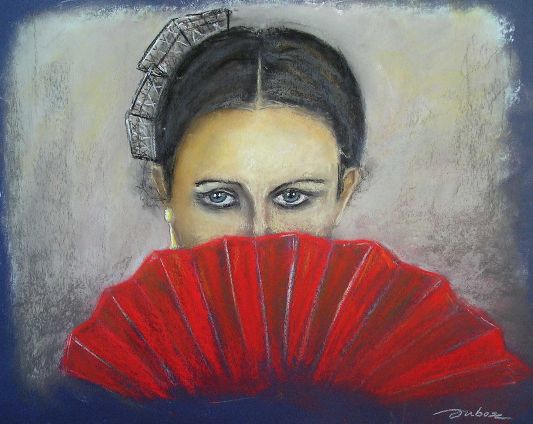A Fan (Abanico) is an instrument and a fashion, which was invented and manufactured in order that manually it could move air and facilitate cooling when you are in a hot environment, without ventilation.
Fan was originated in China. Its operation is very simple, just enough arm waving harmoniously supporting it with more or less intensity, but its manufacture is delicate because it incorporates artistic trims and quality materials.
These are the components of a fan:
--Baraja (Deck): Rigid and folding base of a fan.
--País (Country): The fabric that is attached to the “Baraja”. The fans which have no “país”, are named “de baraja” or simply “Barajas”.
--Varillas (Ribs): Wood that can be fretworked or painted.
--Caberas: First and last ribs, thicker than the rest.
--Calado (Fretwork): Holes made in the ribs.
The Flabélum or the high fan comes from the Egyptian and Asian antiquity, as manifested in the reliefs and paintings at least since the nineteenth dynasty in Egypt. But only used in the palaces.
The Greek civilization made use of the fan from the fifth century before Christ. The Greeks were followed by Etruscans and Romans and it is followed during the Middle Ages, such in civil life as in certain religious civilizations. Fan is to the very different ways and with varied materials, predominantly fabric and feather.
The folding fan was invented by a Chinese in the seventh century, inspired in the mechanism of the wing of a bat. In Europe it is known from the late fifteenth century, where it was brought by the Portuguese people, who opened trade routes to East. It was extended through all Europe and, at the beginning it was used by ladies of high society; but after for all layers of society. In the seventeenth century came to be the way it is now unfolding in recent centuries the whims of fashion and miniaturists introducing inventive fretwork, reliefs, inlays and precious materials. The Mores is a common motif in the design of the "país", where yet fit all kinds of images.
.jpg)
A fan with fretwork
In the eighteenth century Spain settled in the French craftsman Eugenio Prost1, under the protection of the Count of Floridablanca, making Spain one of the world's leading producers competing with French and Italian. That same century guild is created abaniqueros cited and late century, is based in Valencia, the Real Factory Fans.
Although fan was an instrument for ladies, some men also used little fans, in their pockets. And other biger fans, named “Abanicos de pericón” (“Fans of pericón”), specially for Flamenco dance.
However, their use becomes exclusive ladies early twentieth century up to these days, although today you can see men fanning. Apparently these ladies had such skill with the fans, who came to invent a "language of the fan", consisting of the position as it stood or the way as a lady grabbed the fan, it was transmitting a message type or another one.

The language of fan
I want to show you a nice videoclip, by a Spanish singer woman, who I love, named Diana Navarro.This is her song “ Mira lo que te has perdío” (“Look at what you have missed”), where she uses a fan:
Diana Navarro, in Live, with "Mira lo que te has perdío"
Till soon, kind regards,
Luis.
Sponsored by Costaluz Lawyers.
Please click down here:
.jpg)